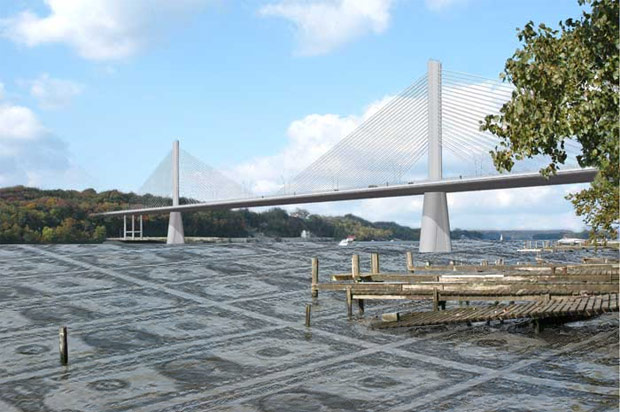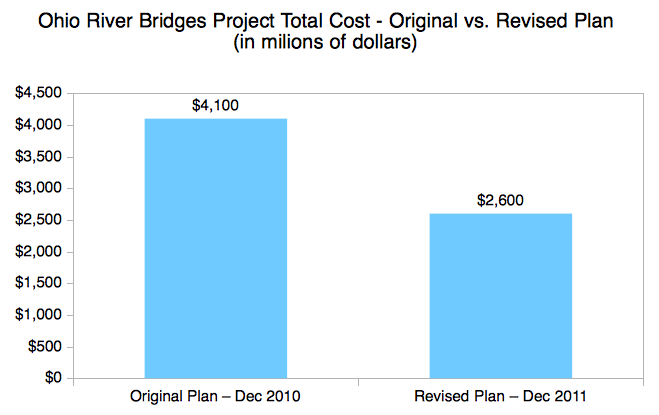[Editor’s Note: Aaron Renn is the Urbanophile, an opinion-leading urban affairs analyst, entrepreneur, speaker, and writer on a mission to help America’s cities thrive in the 21st century. Renn is a native of a small town in Southern Indiana near Louisville.This is the first in a series of articles planned to address the current situation of the Ohio River Bridges Project. This article was originally published on January 9, 2012 and is reprinted with permission.]
– Indiana gives away $1.7 billion to Kentucky –
– Indiana’s costs up by $200 million while total project costs decline by $1.5 billion –
– $432 million diverted from other projects to close funding gap recreated by Indiana’s botched negotiators –
– Tolling likely to mean Indiana pays well over half the project –
– Indiana potentially exposed to major risk by agreeing to build a tunnel in Kentucky through Louisville’s most affluent suburb that the state has no expertise to construct –
I’ve noted before how the Indiana Toll Road lease was a stroke of genius (see “Foreign Investors Hurting, Hoosier Taxpayers Smiling” and “Major Moves Is Majorly Great“). I attribute a lot of it to Gov. Mitch Daniels’ shrewd assessment of the competitive landscape (see “The Shrewdness of Mitch Daniels”). As Daniels is fond of saying, “It was the best deal since Manhattan was sold for beads – only this time the natives won.”
Unfortunately, in the case of Indiana’s recent agreement with Kentucky on a pair of new bridges across the Ohio River at Louisville, this time it’s Indiana taxpayers and motorists who are back in the role of the Indians. I’m a big fan of Indiana Gov. Mitch Daniels, but this is a very bad deal for the state. In a four part series that starts today, I’ll document the reasons why, explaining how:
- Indiana has trumpeted that the cost of the project has declined by $1.5 billion. But in fact Indiana’s share of the cost has actually gone up by nearly $200 million. Kentucky has pocketed more than 100% of the savings—a massive $1.7 billion giveaway by Indiana.
- Indiana’s botched negotiating means $432 million in state highway funds will have to be diverted from other projects around the state in order to cover a funding gap in the project.
- Tolling won’t pay for the bridges, and in any case tolling is likely just another word for “Hoosiers pay.”
- Indiana is potentially exposed to huge financial and political risk because it is agreeing to take on a $261 million “mini-Big Dig” tunnel in Louisville’s most affluent community. From an Indiana perspective this is like having the state outsource a freeway through Zionsville to Ohio.
- The are superior alternatives to the project as a whole that are cheaper too and promise major additional savings on top of the $1.5 billion Indiana and Kentucky have already found.
Today I’ll examine what’s clearly the most incredible piece of the puzzle – how Indiana gave so much money away to Kentucky.
As recently as one year ago in December 2010, the Ohio River Bridges Project – which consists of a new East End Bridge, a new downtown bridge, and a reconfiguration or new construction of the approaches and connecting interchanges – was projected to cost $4.1 billion according to the project financial plan. Given the high cost of the bridge, the two states started looking for ways to save money. In November 2011, INDOT announced a series of design changes that reduced the total project cost by $1.2 billion. In late December 2011, INDOT announced that further changes had raised the total savings to $1.5 billion and also announced that Indiana and Kentucky had reached a new deal on how to split the cost. This reduced the total project cost to a “mere” $2.6 billion.
But while the total project cost declined by $1.5 billion because of these changes, Indiana’s cost actually went up by almost $200 million. That’s right, while taking $1.5 billion in total cost out of the project, Indiana managed to make its share of the project actually go up in cost. Kentucky’s cost, by contrast, declined by almost $1.7 billion. Indiana gave away more than 100 percent of the cost savings achieved by the project design changes.
This is truly stunning. We’re talking huge money here—more than INDOT is spending on I-69 under Major Moves, the state’s flagship project.
How is this possible? It’s pretty simple. In addition to changing the project to reduce the cost, Indiana also agreed to change the way the two states split the cost of the project. Previously, it was a pretty simple cost exercise: Indiana paid 100 percent of everything on its side of the border, Kentucky paid for 100 percent of everything on its side of the border, and the two states would split 50/50 the cost of the bridges themselves. I might quibble with this. For one thing, as Kentucky is always fond of pointing out, it owns the Ohio River. I would have thought that would be a negotiating point. There are also other approaches I might prefer on efficiency grounds, but at least this makes sense and is intuitively fair. Because there were two major pieces of construction exclusively in Kentucky – the reconstruction of Spaghetti Junction and a dubious $261 million tunnel on the East End approach (more on that later)—Kentucky’s share of the cost, as it should have been under any reasonable scenario, was higher than Indiana’s—73 percent vs. 27 percent.
In the new agreement, Indiana and Kentucky agreed to split the cost 50/50. Indiana would be responsible for the East End bridge and the approach work in both states, while Kentucky would be responsible for the downtown bridge and the approach work in both states.
Why would Indiana agree to this? I’m not sure, but I can’t think of anything it actually got in return for it. 50/50 has some intuitive appeal, but as I said before, there’s a lot of work on the Kentucky side of the river that benefits exclusively Kentucky (such as the aforementioned tunnel). It’s not clear why Indiana should pay for that. The original deal concept was basically fair. The lion’s share of the regional population, and likely of the economic benefits of the bridge, is in Kentucky. It’s hard to think of anything where the numbers suggest anything close to an equal split of the cost, except perhaps the makeup of traffic on the bridge. And when it comes to that, Indiana is already going to more than pay thanks to the toll financing (see part two).
At the end of the day, INDOT cut a simply horrible deal, giving away $1.7 billion to Kentucky (or at a minimum its $850M share) in return for nothing. If you are Evansville and wondering how the state will ever finish I-69, or Northwest Indiana wondering why the state doesn’t have the cash to replace the Cline Ave bridge, or Indianapolis wondering why the state booted an upgrade of the state’s most congested corridor out of Major Moves, or Fort Wayne wondering why so many of your important projects have gotten pushed out, I suggest looking no further than this lousy deal for answers.
I’m sure Gov. Daniels is very eager to get this project started as yet another building block in his strong legacy around transport infrastructure. But he shouldn’t be this eager. I can’t help but wonder who he had doing the negotiation on Indiana’s behalf, because he’s way too smart to have cut a deal this bad himself.
The revised cost split is the worst, though hardly the only, problem with this agreement. In part two I’ll examine how toll funding shifts even further financing to the Hoosier State.
Indiana’s Bridge Deal Boondoggle
Part One: A Financial Fiasco (this article)
Part Two: Hoosiers to Pay Even More With Tolling
Part Three: INDOT’s Mini-Big Dig
Part Four: A Better Way






Indiana wants that East End Bridge badly enough so the Old Ammo Plant that runs up Ind 62 can be developed to its full potential. I see no problem with Gov. Daniels hedging a bet on the “if you built it, they will come” attitude when it comes to expanding the tax base and job potental that can be fully unlocked when this large swatch of industral use land can be redeveloped easier with better access to Interstates 71 & 64.
I certainly agree with what chef Dan said as far as why Indiana needs and will benefit excessively from the east end bridge while it will do nothing for Kentucky. Also the author of this article stated that the tunnel will go under in affluent neighborhood when in reality it’s actually going to go under a vacant field! The fact that that field as part of a supposedly historic property is the only reason the tunnel is being required. Cost splitting for this entire project is certainly the best move for everyone in the long run because it will get the job completed without further delays!